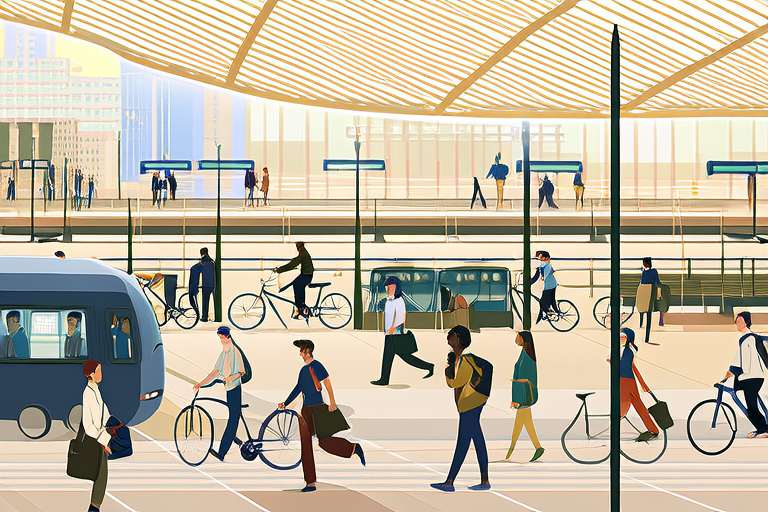How to Choose the Right Public Transportation: A Comprehensive Guide for Commuters
Introduction
Choosing the right public transportation can significantly impact your daily commute, affecting not only your time but also your overall well-being. Whether you’re a seasoned commuter or just starting out, making informed decisions about which mode of public transport to use can save you money, reduce stress, and even improve your health. In this comprehensive guide, we’ll explore various factors to consider when selecting the best public transportation option for your needs.
Understanding Your Commute Needs
Before diving into specific modes of transportation, it’s crucial to understand your commuting requirements. Consider the following aspects:
Distance and Frequency
The distance between your home and workplace plays a significant role in determining the most suitable form of public transport. For short distances, walking or biking might be ideal. For longer distances, buses, trains, or subways could be more efficient. Additionally, think about how frequently you need to travel. If you work irregular hours, a flexible service like ride-sharing apps might be preferable.
Schedule and Timing
Public transportation schedules vary widely. Some routes may run less frequently during off-peak hours, which could affect your punctuality. Check timetables and plan accordingly. Many cities offer real-time tracking apps that can help you stay on schedule.
Accessibility
Accessibility is key, especially if you have mobility challenges or need to travel with children or large items. Ensure that the chosen mode of transport is equipped with ramps, lifts, and other necessary facilities. Also, consider the ease of transferring between different lines or services.
Types of Public Transportation
Once you’ve identified your needs, it’s time to explore the different types of public transportation available. Each has its own advantages and disadvantages, so it’s important to choose wisely.
Buses
Buses are one of the most common forms of public transport. They are generally affordable and cover a wide area, making them accessible to many commuters. However, they can be slower than other options due to traffic congestion. Buses are particularly useful for shorter trips within urban areas.
Trains and Subways
Trains and subways are often faster and more reliable than buses, especially for long-distance commutes. They operate on dedicated tracks, reducing delays caused by traffic. However, they may not be as frequent or accessible as buses, particularly in less populated areas.
Light Rail and Trolleys
Light rail and trolleys offer a balance between speed and convenience. They typically run on fixed tracks but can navigate through city streets, providing greater flexibility. These systems are popular in many European cities and increasingly in North America.
Ride-Sharing Services
Ride-sharing services like Uber and Lyft provide an alternative to traditional public transport. They offer door-to-door service and can be booked on-demand, making them convenient for irregular schedules. However, they tend to be more expensive than other options and may not always be available in all areas.
Practical Tips for Efficient Commuting
To make your commute smoother and more enjoyable, here are some practical tips:
Plan Ahead
Use online tools and apps to plan your route in advance. Many cities offer official transit websites and mobile apps that provide real-time information on schedules, delays, and transfers. This can help you avoid surprises and manage your time better.
Pack Smart
Pack only what you need for your commute. Bring a reusable water bottle, a book, or headphones to pass the time. Keep essentials like keys, wallet, and phone easily accessible. Consider using a backpack or tote bag for comfort and convenience.
Stay Safe
Safety should always be a priority. Familiarize yourself with the layout of stations and vehicles. Avoid peak hours if possible, as crowded conditions can increase the risk of theft. Trust your instincts and report any suspicious behavior to authorities.
Case Study: Commuter’s Journey from City Center to Suburbs
Let’s look at a real-world example of how these principles can be applied. Imagine Sarah, who works downtown but lives in the suburbs. She needs a reliable and cost-effective way to get to work every day. After researching her options, she decides to take a combination of bus and train services.
Step-by-Step Process
- Research Options: Sarah uses her city’s transit website to find routes and schedules.
- Plan Her Route: She identifies the bus line that runs closest to her home and the nearest train station.
- Purchase Tickets: Sarah buys a monthly pass for both the bus and train services to save money.
- Stay Informed: She downloads a real-time tracking app to monitor her bus and train times.
- Pack Efficiently: Sarah prepares her bag the night before, ensuring she has everything she needs for the day.
By following these steps, Sarah ensures a smooth and stress-free commute every day.
Conclusion
Choosing the right public transportation involves careful consideration of your individual needs, including distance, schedule, and accessibility. By understanding the different types of public transport available and implementing practical tips, you can optimize your commute and enhance your daily routine. Remember, the goal is to find a solution that fits your lifestyle and keeps you safe, comfortable, and on time. Start by assessing your unique requirements and then explore the various options available in your area. Happy commuting!
